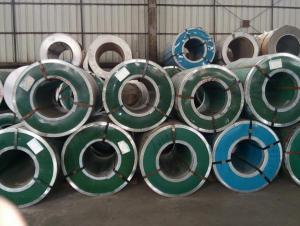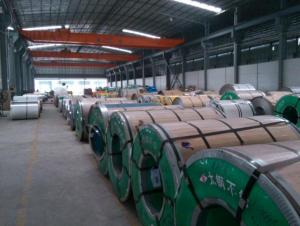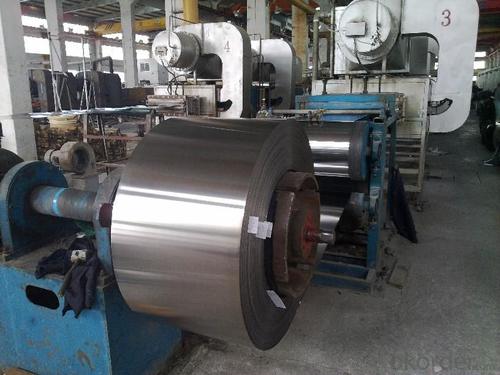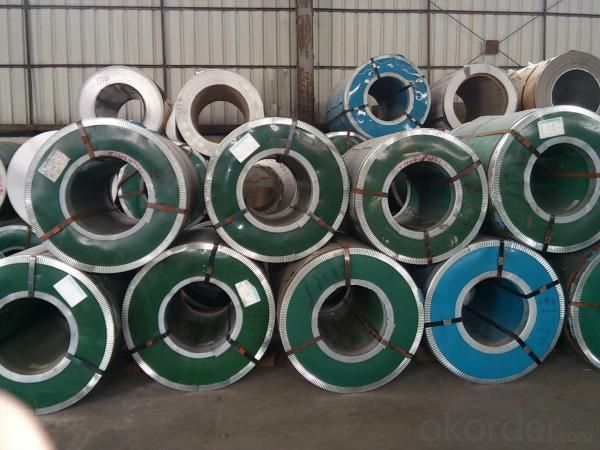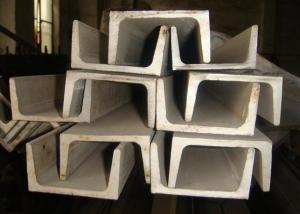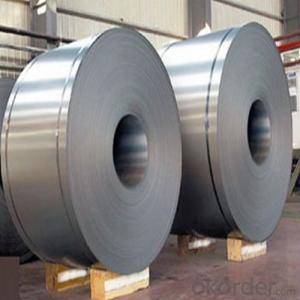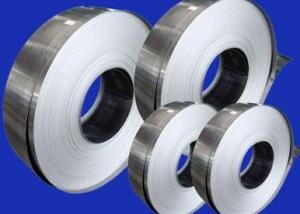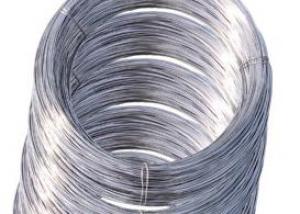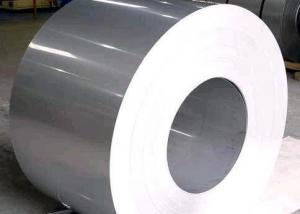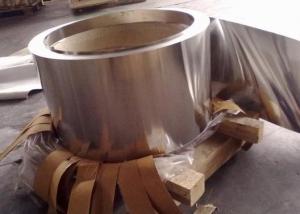Best Quality Stainless Steel Wire Mesh Coil
- Loading Port:
- China Main Port
- Payment Terms:
- TT or LC
- Min Order Qty:
- 1 Ton m.t.
- Supply Capability:
- 30000ton per month m.t./month
OKorder Service Pledge
OKorder Financial Service
You Might Also Like
AISI 304 Stainless Steel Coil
1. Chemical Composition
C | Si | Mn | P | S | Ni | Cr |
max0.08 | max1.00 | max2.00 | max0.045 | max0.03 | 8.00-10.50 | 18.00-20.00 |
2. Mechanical Properties
Yield Strength | Tensile | Elongation | Hardness (HV) | Hardness (HRB) |
≥ 205 | ≥ 520 | ≥ 40 | ≤ 200 | ≤ 90 |
3. Standard: AISI, ASTM, GB, EN, DIN, JIS
4. Surface: 2B, NO.1, BA, NO.4, Hairline, SB, Mirror finish, Anti-skid, Cherkered etc.
5. Size:
Thickness: 0.3-3mm (cold rolled), 3-40mm (hot rolled)
Width: 1000mm or 1219mm or 1240mm for cold rolled, 1500mm for hot rolled.
Length: As customers' request.
6. MOQ: 1 Ton
7. Payment terms: T/T or L/C
8. Packing: Seaworthy package with wooden or Iron pallets with the paper and the steel strip, or as customers' request.
9. Delivery time: Usually about 7 days after we confirming the order, or according to your quantity.
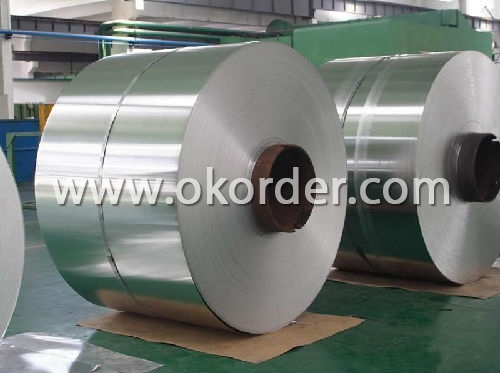

- Q:What are the different types of stainless steel wire alloys?
- There are several different types of stainless steel wire alloys, including austenitic, ferritic, martensitic, and duplex stainless steels. Each alloy has unique properties and is suitable for different applications.
- Q:Can stainless steel wire be used for springs in the agricultural industry?
- Yes, stainless steel wire can be used for springs in the agricultural industry. Stainless steel is known for its excellent corrosion resistance, which makes it ideal for agricultural applications where the springs may be exposed to harsh environments or chemicals. Additionally, stainless steel wire has high tensile strength and good elasticity, enabling it to withstand heavy loads and repeated usage. These properties make stainless steel wire springs suitable for various agricultural machinery and equipment, such as tractors, plows, harvesters, and irrigation systems.
- Q:What are the different wire forms available for stainless steel wire?
- Stainless steel wire offers a variety of wire forms, each with its own unique characteristics and uses. 1. The most common form is round wire, available in different diameters. It finds application in general wire forming, jewelry making, and industrial uses. 2. Flat wire, as the name suggests, has a flat shape. It is ideal for applications requiring a wider and thinner profile, such as springs, clips, and electrical contacts. 3. Square wire offers additional strength and stability due to its square cross-sectional shape. It is commonly used in high-tensile applications like springs, fasteners, and mechanical components. 4. Shaped wire refers to stainless steel wire formed into specific shapes like triangles, rectangles, or hexagons. It is used in specialized applications like architectural facades, filtration systems, and decorative elements. 5. Braided wire consists of multiple strands woven together, creating a flexible and strong structure. It is commonly used in applications that require flexibility and conductivity, such as cables, hoses, and electrical grounding. 6. Welding wire is designed specifically for welding applications. It comes in different diameters and compositions to suit various welding processes and materials. It is widely used in automotive, construction, and manufacturing industries. In conclusion, the availability of different wire forms for stainless steel wire ensures that there is a suitable option for various needs in different industries, allowing for a wide range of applications.
- Q:Which is good, copper wire stop valve and stainless steel wire stop valve?
- The copper cut-off valve is cracking, but the price comparison of stainless steel valve copper valve may be a cheap price, you can buy 2-3 stainless steel valve copper valve, mainly to see whether you think that if the budget is enough.
- Q:How is stainless steel wire manufactured?
- Wire drawing is the method utilized to manufacture stainless steel wire. This technique comprises pulling a stainless steel rod or billet through a succession of dies to decrease its diameter and increase its length. To commence the manufacturing process, the appropriate grade of stainless steel must be chosen, which may differ depending on the desired wire properties. The most common grades are 304, 316, and 430 stainless steel, each possessing distinct compositions and characteristics. Once the stainless steel rod or billet is selected, it undergoes a cleaning and lubrication process to facilitate the wire drawing. This aids in reducing friction and heat generation during the drawing operation. The subsequent step involves passing the stainless steel rod or billet through a series of dies, usually made of tungsten carbide or diamond. These materials possess extreme hardness, allowing them to shape the stainless steel without causing excessive wear. Each die in the series has a slightly smaller diameter than the previous one, resulting in the stainless steel being drawn through progressively smaller openings. As the stainless steel passes through each die, its diameter decreases and its length increases. This process is repeated several times until the desired diameter and length of wire are achieved. Throughout the wire drawing process, the stainless steel wire is periodically annealed to relieve internal stresses and enhance its ductility. Annealing involves heating the wire to a specific temperature and then slowly cooling it. This process improves the wire's mechanical properties and makes it easier to work with. Once the stainless steel wire reaches the desired diameter, it undergoes further processing to eliminate any surface defects or imperfections. Typically, this is accomplished through pickling, which involves immersing the wire in an acid solution to remove any oxide layers or scale that may have formed during manufacturing. Following pickling, the stainless steel wire may undergo additional processes such as coating or heat treatment, depending on its intended application. These processes can further enhance the wire's corrosion resistance, strength, or other desired properties. Upon completion of the manufacturing process, the stainless steel wire is typically wound onto spools or reels for storage and transportation. It can then be utilized in various applications, such as construction, automotive, or industrial purposes. In summary, the manufacturing of stainless steel wire combines precision engineering, material selection, and various processing techniques to produce a versatile and high-quality product.
- Q:Is stainless steel wire corrosion-resistant?
- Yes, stainless steel wire is corrosion-resistant. Stainless steel is an alloy that contains a high percentage of chromium, which forms a protective oxide layer on the surface of the metal. This oxide layer acts as a barrier, preventing oxygen and moisture from reaching the underlying steel, thereby reducing the risk of corrosion. The chromium content also enhances the wire's resistance to other corrosive elements, such as acids and chemicals, making it suitable for various applications where corrosion resistance is crucial, such as in marine environments or outdoor settings.
- Q:What are the different types of stainless steel wire springs used in the electronics industry?
- In the electronics industry, there are several types of stainless steel wire springs commonly used due to their excellent electrical conductivity, corrosion resistance, and durability. Some of the different types of stainless steel wire springs used in the electronics industry include: 1. Compression Springs: These springs are widely used in electronic devices to provide resistance and absorb shock or pressure. They are commonly found in connectors, switches, and various electronic assemblies. 2. Torsion Springs: Torsion springs are used to provide rotational force or torque in electronic devices. They are often found in various mechanisms like switches, relays, and circuit breakers, where rotational movement is required. 3. Extension Springs: Extension springs are used in electronic devices where linear force needs to be applied. They are commonly found in battery contacts, connectors, and other devices that require tension to hold components or provide a restoring force. 4. Constant Force Springs: These springs provide a constant force over a specific range of extension. They are frequently used in applications such as retractable cords, cable management systems, and electronic devices where a consistent force is required. 5. Wave Springs: Wave springs are used in electronic devices where space is limited. They provide a high load capacity in a compact design and are commonly used in miniature electronic connectors, switches, and various microelectronic assemblies. 6. Wire Form Springs: Wire form springs are versatile and can be custom-designed to meet specific requirements in the electronics industry. They are used in a wide range of applications such as clips, contacts, connectors, and various mechanical assemblies. 7. Battery Springs: These springs are specifically designed for use in battery compartments or battery contacts. They ensure proper electrical contact, maintain a secure fit, and provide a reliable power connection in electronic devices that use batteries. It is important to note that the selection of the appropriate stainless steel wire spring depends on the specific requirements of the electronic device, including the desired force, space limitations, electrical conductivity, corrosion resistance, and environmental conditions.
- Q:What is stainless steel wire?
- Stainless steel wire, a highly durable and corrosion-resistant alloy, is crafted from stainless steel. Its composition primarily consists of iron, along with the incorporation of chromium, nickel, molybdenum, and other elements to enhance its qualities. These elements create a protective layer on the wire's surface, safeguarding it against rust, tarnish, and staining. Due to its distinctive characteristics, stainless steel wire finds extensive use across a wide array of industries, including construction, automotive, aerospace, and electronics. Its strength, flexibility, and ability to withstand harsh conditions make it a preferred choice in these sectors. The versatility of stainless steel wire renders it suitable for various purposes. It can be effectively employed in the production of wire mesh, fencing, cables, springs, and other components utilized in different machinery and equipment. Moreover, it is frequently utilized in the manufacturing of household items like kitchen utensils, jewelry, and medical instruments. To summarize, stainless steel wire boasts exceptional corrosion resistance, durability, and versatility. Its superior properties have made it a highly sought-after option for diverse applications in numerous industries.
- Q:What is the weight of stainless steel wire per meter?
- The weight of stainless steel wire per meter can vary depending on the diameter and specific type of stainless steel used. However, as a general estimate, stainless steel wire typically weighs around 0.5 to 1.5 kilograms per meter.
- Q:Is stainless steel wire suitable for wire rope saddles?
- Yes, stainless steel wire is suitable for wire rope saddles. Stainless steel wire has excellent corrosion resistance and high strength, making it a reliable choice for wire rope saddles that need to withstand heavy loads and harsh environments.
1. Manufacturer Overview |
|
|---|---|
| Location | Zhejiang,China |
| Year Established | 2000 |
| Annual Output Value | Above US$8.3 Million |
| Main Markets | Europe, America |
| Company Certifications | ISO9001:2000 |
2. Manufacturer Certificates |
|
|---|---|
| a) Certification Name | |
| Range | |
| Reference | |
| Validity Period | |
3. Manufacturer Capability |
|
|---|---|
| a)Trade Capacity | |
| Nearest Port | Shanghai |
| Export Percentage | 30% |
| No.of Employees in Trade Department | 30 People |
| Language Spoken: | English;Chinese |
| b)Factory Information | |
| Factory Size: | Above 80,000 square meters |
| No. of Production Lines | Above 7 |
| Contract Manufacturing | OEM Service Offered;Design Service Offered |
| Product Price Range | Average |
Send your message to us
Best Quality Stainless Steel Wire Mesh Coil
- Loading Port:
- China Main Port
- Payment Terms:
- TT or LC
- Min Order Qty:
- 1 Ton m.t.
- Supply Capability:
- 30000ton per month m.t./month
Offcanvas right
OKorder Service Pledge
OKorder Financial Service
Similar products
New products
Hot products
Hot Searches
Related keywords

